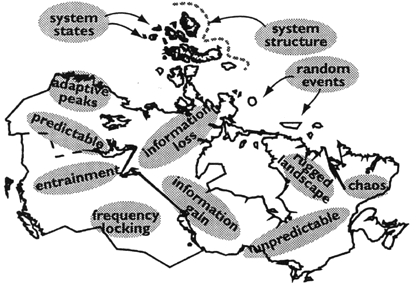
|
||
| Map-makers,
Explorers, and Tricksters: New Roles for Planning and Prediction in Nonlinear, Complex Systems
|
||
| Planning and
The Geography of Predictability Traditionally, successful planning was supposed to rest on two interrelated achievements: accurate prediction of the future combined with an implementation strategy carefully tailored to these predictions. For instance, Ackerman (1982) claimed that successful organizational change resulted not only from an "impact analysis" of how the planned change will specifically effect the organization's functions, people, and management systems, but the ability of planners to predict, ahead of time, at what pace this change will proceed! And, Zeira and Avedisian (1990) proposed a planning procedure based so primarily on the accuracy of the initial forecast that success was supposed to altogether hinge on the initial assessment of the current status of the organization.
Figure 1: Planning as Cartography
|
||
Indeed, this linkage of planning with accurate prediction runs deep in our classical scientific and philosophical heritage. For example, Isaac Newton believed he had managed by means of his calculus to unfailingly predict the future state of a system - all that was needed was an accurate measurement of initial conditions and the appropriate equations of motion (Ekeland, 1988). Linking effective planning to this ideal of predictability indeed sounds like a commendable endeavor for an organization. The only problem is that Newton s promise of predictability was for a world mainly conceived as linear, simple, and stable, whereas complexity research is revealing a world composed of systems that are nonlinear, complex, and unstable. In such a new world, Newton's type of predictability can no longer reign supreme. Of course, this is true not only from a mathematical or physical point of view, for who can, in our tumultuous and unstable healthcare environment, seriously entertain the belief that predicting the future is possible anymore (outside of trivial considerations of current trends)? Instead of a stable environment, instability is the name of the game: shifts in the workforce; the unexpected rise of resistant bacteria and apparently new viruses; changes in healthcare financing and insurance; unexpected shifts in governmental regulations; the unprecedented rise and fall of for-profit ventures; technological innovations; demographic shifts in the marketplace; and on and on. Furthermore, are prediction and accurate anticipation really what's so crucial for organizational change efforts? Dyers (1985), for example, in his studies of the planned change of corporate cultures, points out that in many cases significant changes were not planned, but were, instead, precipitated by unanticipated financial shifts, crises, illnesses, and even deaths of leaders. And, Westley (1990) found that unexpected changes, spontaneously accompanying planned change efforts, often had more lasting influence on an organization than the original plans themselves.
|
||
|
Next | Previous Copyright © 2001, Plexus Institute
Permission |
